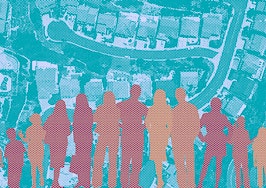Despite extensive efforts to improve homeownership rates among minority communities, systemic inequalities in housing, education, jobs and finance have continued to widen the homeownership gap, according to the National Association of Realtors’ 2021 Snapshot of Race and Homebuying in America report.
At 42 percent, Black Americans’ homeownership rate is 27.8 percent behind white Americans (69.8 percent), 18.7 percent behind Asian Americans (60.7 percent) and 6.1 percent behind Hispanic Americans. White Americans are the only group to have a homeownership rate that’s on par with the national average (64.2 percent).

Lawrence Yun
NAR Chief Economist Lawrence Yun explained the disparities for minority communities stem from a lack of wage growth, greater job insecurity and higher student loan debt levels, all of which make it harder to find affordable housing and secure a mortgage.
“The residential housing market’s strong performance during the pandemic helped homeowners enjoy a significant increase in wealth via approximately $1 trillion in additional home equity over the last year,” he said. “However, as indicative of the K-shaped economic recovery, greater numbers of potential first-time homebuyers – many of whom are minorities – are feeling discouraged by disproportionate job losses.”
“Essentially, they’re being priced out of owning a home because of rapidly rising home prices resulting from historically low housing inventory,” he added. “For Black Americans, in general, the greater likelihood of having student loan debt, combined with lower household incomes and accrued savings when compared to the national average, adds to the challenge.”
Black Americans are twice as likely to have student loan debt than white Americans (43 percent versus 21 percent), with Black households carrying a higher median debt ($40,000) than their white counterparts ($30,000). The higher debt rate has contributed to higher mortgage denial rates, the report explained. Ten percent of Black Americans who applied for a mortgage in 2019 were denied, compared to only 4 percent of white applicants.
In addition to higher mortgage denial rates, Black Americans have a more difficult time locating affordable housing with only 43 percent of Black homebuyers being able to afford the typical home. Asian Americans fared the best in this category (71 percent), followed by white Americans (63 percent) and Hispanic Americans (54 percent).
However, the report noted there are states where Black Americans have better (Alaska, Kansas, Nebraska, South Dakota, and Vermont) or worse (California, Colorado, Hawaii, Massachusetts, Montana, Nevada, Oregon, Utah, Washington state, Wyoming and the District of Columbia) affordability outlooks.
When it comes to funding their homebuying journey, Black Americans (15 percent) and Hispanic Americans (10 percent) are the most likely to tap into their 401K funds to provide a down payment or cover other housing costs. Black (17 percent), Asian (18 percent) and Hispanic (21 percent) homesellers are also less likely than whites (37 percent) to use the proceeds from the sale of their former residence to fund the down payment for their next home.
With several barriers to homeownership in their way, some minority homebuyers are still pursuing homeownership through multigenerational living arrangements. Twenty-three percent of Asian Americans, 18 percent of Hispanic Americans, and 15 percent of Black Americans live with family members to “save money” and “spend time with aging parents.”

NAR President Charlie Oppler
Lastly, the report highlighted the issue of discrimination, with 41 percent of Black Americans, 27 percent of Asian Americans, 19 percent of Hispanic Americans and only 16 percent of white Americans saying they’ve “witnessed or experienced discrimination in a real estate transaction.”
NAR President Charlie Oppler said the report highlights the need for systemic changes in the real estate industry, which the association outlined in its five-point plan released last year. Oppler also said he supports President Biden’s housing policy, which includes a $15,000 first-time buyer tax credit.
“This data reinforces the need to implement key policy initiatives NAR developed in concert with the Urban Institute and the National Association of Real Estate Brokers to address the Black homeownership gap,” he said.
“Specifically, this five-point plan developed in 2019 calls on the nation to: advance policy solutions at the local level; tackle housing supply constraints and affordability; promote an equitable and accessible housing finance system; provide further outreach and counseling initiatives for renters and mortgage-ready millennials, and focus on sustainable homeownership and preservation initiatives.”








